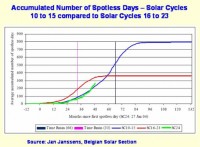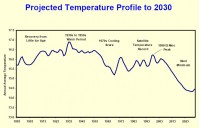By David Archibald at the ICCC
Do we live in a special time in which the laws of physics and nature are suspended? No, we do not. Can we expect relationships between the Sun’s activity and climate, that we can see in data going back several hundred years, to continue for at least another 20 years? With absolute certainty. In this presentation, I will demonstrate that the Sun drives climate, and use that demonstrated relationship to predict the Earth’s climate to 2030. It is a prediction that differs from most in the public domain. It is a prediction of imminent cooling.
The sun reverses magnetic polarity with each solar cycle, and sunspots of the new cycle start forming before the old cycle has completely died off. The average length of a solar cycle is 10.7 years. Solar Cycle 23 started in May 1996, rising to a peak of 120.9 in April 2000. For Solar Cycle 23 to be of average length, Solar Cycle 24 should have started in January 2007. The first sunspots of a new solar cycle appear usually at more than 20 degrees latitude on the Sun’s surface. According to the last couple of solar cycles, the first sunspots appear twelve to twenty months prior to the start of the new cycle. With the first sunspot of Solar Cycle 24 seen on 4th January, 2008, Solar Cycle 24 may start from late 2008 to mid-2009.

See larger image here
This graph is another pointer that we are heading back to the weak solar cycles of the 19th century, with 19th century type winters to accompany them. Solar cycles 10 to 15, from 1860 to 1917, had an average of 66 months from the first spotless day to solar cycle minimum. This was a time of considerable glacial advance in the European Alps. Since then, solar cycles have averaged half that at 33 months from first spotless day to solar cycle minimum. So far, solar cycle 24 is plotting on the 19th century line. With the first spotless day on 27th January, 2004, and if the 66 month observation holds, then solar minimum will be on or about July 2009. This would make solar cycle 23 thirteen years long.
Combining the rural US data set we saw earlier and the projected temperature response to the length of Solar Cycle 23, this graph shows the expected decline to 2030.

See larger image here
The temperature decline will be as steep as that of the 1970s cooling scare, but will go on for longer. It can get worse than a repeat of the Dalton Minimum. Ken Schatten is the solar physicist with the best track record in predicting solar cycles. His work suggests a return to the advancing glaciers and delayed spring snow melt of the Little Ice Age, for an indeterminate period. He told the American Astronomical Association Meeting in 2003 that based on his model “The surprising result of these long-range predictions is a rapid decline in solar activity, starting with cycle #24. If this trend continues, we may see the Sun heading towards a “Maunder” type of solar activity minimum - an extensive period of reduced levels of solar activity.” See this full paper that makes the case for the role of the sun in driving climate (with some US city data and forecasts) and for the folly of being so concerened about carbon here.


